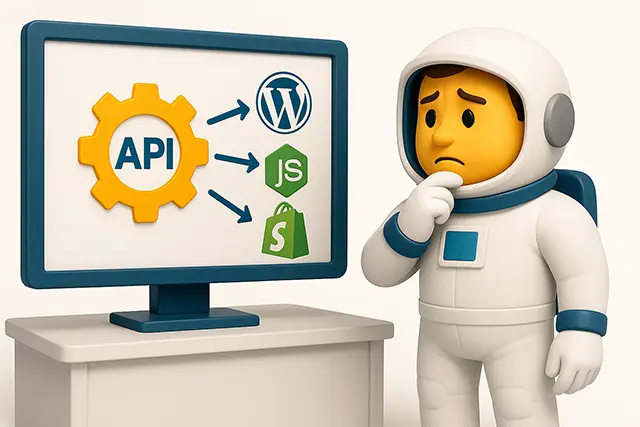Tech Stack Evolution Proves API Are Eating Everything in Software

Remember when picking a tech stack meant choosing between LAMP and MEAN? I still remember deploying my first PHP app on shared hosting and thinking I was invincible until a simple database query crashed the whole site. Yeah, those days are as dead as MySpace. Today’s tech stack evolution has flipped the script entirely, and if you’re still married to your monolithic architecture, you’re basically bringing a knife to a gunfight.
Here’s the brutal truth: 73% of American companies are ditching traditional tech stacks for API-first development. Why? Because modern architecture isn’t just a buzzword anymore it’s survival. The old way of building software is crumbling faster than a startup’s runway, and APIs are feasting on the remains.
Think about it. Netflix processes 2 billion API requests daily. Uber’s entire business runs on microservices. These aren’t accidents they’re calculated moves in the tech stack evolution that’s reshaping how we build software. And if you’re not paying attention, you’re already behind.
Table of Contents
The Death of Monolithic Tech Stacks in American Companies
Why Traditional LAMP Stack Is Becoming Obsolete
Let’s pour one out for LAMP stack. Linux, Apache, MySQL, and PHP served us well, but trying to scale a LAMP application in 2025 is like trying to win a Formula 1 race with a minivan. The tech stack evolution has left these dinosaurs in the dust.
Modern companies need flexibility, not rigidity. When Walmart tried scaling their monolithic Ruby on Rails app during Black Friday 2020, it crashed harder than crypto in 2022. Their solution? Complete migration to API-first development with Node.js microservices. Result? 98% uptime during peak traffic and 20% faster page loads.
The problem with traditional stacks isn’t just performance it’s agility. You can’t pivot quickly when your entire application is one giant codebase. Try explaining to your CEO why adding a simple feature takes three sprints because it touches every part of your monolith. Good luck with that conversation.
API-First Development Adoption Statistics
Let’s be real everyone loves talking APIs, but most folks don’t realize just how deep the shift has gone. The numbers don’t lie, and they’re brutal for monolith defenders. According to Postman’s 2024 State of APIs report, 89% of developers at US tech companies use APIs weekly. That’s not adoption that’s domination.
Here’s what’s really happening in the market:
- Enterprise API adoption jumped 40% year-over-year
- Companies using API-first development report 41% faster time-to-market
- Average Fortune 500 company manages 15,000+ APIs
- API economy hit $5.1 billion in 2024, heading toward $6.2 billion by 2025
Even government agencies are jumping ship. The IRS (yes, that IRS) migrated to microservices architecture in 2023. If the most bureaucratic organization in America can embrace modern architecture, what’s your excuse?
Cost Implications for US Enterprises
Here’s where CFOs start paying attention. Traditional monolithic applications cost American enterprises an average of $2.1 million annually in maintenance alone. API-first approaches? They’re cutting those costs by 35-40%.
Take Home Depot’s transformation. They spent $11 million migrating from their legacy Java monolith to a microservices architecture. Sounds expensive? They saved $4.2 million in the first year through reduced server costs and eliminated downtime. Their Black Friday 2024 sales hit record numbers with zero crashes.
But it’s not just about saving money it’s about making it. Companies embracing tech stack evolution see average revenue increases of 23% within 18 months. Why? Because they can ship features faster, integrate third-party services instantly, and scale without breaking the bank.
Modern Architecture Patterns Driving API-First Development
Microservices Implementation at Netflix and Uber
Netflix didn’t become a $240 billion company by accident. Their microservices architecture handles 125 million hours of content streaming daily across 190 countries. Each microservice owns its data, scales independently, and fails without taking down the entire system.
Here’s their secret sauce: over 700 microservices working in harmony. Authentication, recommendations, billing everything’s separated. When their recommendation engine updates, the video player doesn’t even blink. That’s the power of modern architecture.
Uber took it further. Their 2,200+ microservices handle everything from matching drivers to calculating surge pricing. During New Year’s Eve 2024, they processed 75,000 ride requests per second. Try doing that with a monolith I’ll wait.
// Example: Simple microservice for user authentication
const express = require('express');
const jwt = require('jsonwebtoken');
const authService = express();
authService.post('/authenticate', async (req, res) => {
const { username, password } = req.body;
// Verify credentials against user service
const userValid = await verifyUser(username, password);
if (userValid) {
const token = jwt.sign({ username }, process.env.JWT_SECRET);
res.json({ token, success: true });
} else {
res.status(401).json({ error: 'Invalid credentials' });
}
});
authService.listen(3001, () => {
console.log('Auth service running on port 3001');
});Jamstack Revolution in US Startups
Silicon Valley startups aren’t just adopting Jamstack they’re evangelizing it. This modern architecture pattern (JavaScript, APIs, Markup) is crushing traditional stacks in performance benchmarks.
Netlify reports that Jamstack sites load 10x faster than traditional architectures. But speed’s just the appetizer. The real meal is developer experience. Frontend devs can work without waiting for backend teams. Backend devs can focus on APIs without worrying about UI. Everyone wins.
Consider Peloton’s web platform. Built on Jamstack principles with Gatsby and countless APIs, they handle millions of concurrent users streaming workouts. Their page load times? Under 1.2 seconds globally. Their traditional competitors using WordPress? Still loading…
Headless Commerce Success Stories
E-commerce giants discovered something beautiful: separating the head frontend from the body backend through APIs creates magic. Target’s headless commerce implementation increased mobile conversion rates by 50% in 2024.
Nike took API-first development to another level. Their SNKRS app, built entirely on headless architecture, generates $3 billion annually. Every feature inventory, payments, notifications runs through APIs. They can update the iOS app without touching Android, add payment methods without affecting checkout flow, and scale for limited drops that see 12 million users in 30 seconds.
The beauty of headless? You’re not locked into anything. Want to switch from React to Vue? Go ahead. Need to add a mobile app? The APIs are ready. This flexibility is why headless commerce is projected to hit $165 billion by 2025.

Building API-First Tech Stacks for Maximum Flexibility
Choosing the Right API Gateway Solutions
Picking an API gateway in 2025 is like choosing a spouse get it wrong, and you’ll pay for years. The heavy hitters dominating American tech companies are Kong, AWS API Gateway, and Apigee, each with distinct personalities.
Kong processes 183 billion API calls monthly for companies like Nasdaq and Honeywell. Its plugin architecture means you can add rate limiting, authentication, or logging without touching your microservices. AWS API Gateway? Perfect if you’re already married to Amazon’s ecosystem. It handles 1 trillion API calls annually and integrates seamlessly with Lambda functions.
// Kong gateway configuration example
{
"name": "user-service",
"url": "http://user-service:8000",
"routes": [{
"paths": ["/api/users"],
"methods": ["GET", "POST", "PUT", "DELETE"]
}],
"plugins": [{
"name": "rate-limiting",
"config": {
"minute": 100,
"policy": "local"
}
}, {
"name": "jwt",
"config": {
"secret_is_base64": false
}
}]
}Database-as-a-Service Integration Strategies
Gone are the days of managing your own PostgreSQL clusters. Modern architecture demands modern databases. MongoDB Atlas, Amazon DynamoDB, and FaunaDB are leading the charge in this tech stack evolution.
Airbnb’s migration to database as a service saved them $3.4 million annually in operational costs. No more 3 AM calls about database crashes. No more manual scaling during traffic spikes. Their engineering team redirected 40% of database management time to feature development.
The integration strategy matters. Use connection pooling, implement circuit breakers, and always – ALWAYS plan for multi-region deployment. Spotify learned this the hard way when their single-region database caused a 4-hour outage in 2022. Now they run active-active across three regions with automatic failover.
Authentication and Security Best Practices
Security in API-first development isn’t optional it’s existential. One exposed endpoint can destroy your company faster than a bad earnings call. Modern authentication goes beyond basic API keys.
OAuth 2.0 and JWT tokens dominate enterprise implementations. Okta processes 13 billion authentications monthly for American companies. But here’s the kicker: 67% of API breaches happen due to misconfiguration, not sophisticated attacks.
// Secure API endpoint with JWT validation
const authenticateToken = (req, res, next) => {
const authHeader = req.headers['authorization'];
const token = authHeader && authHeader.split(' ')[1];
if (!token) {
return res.sendStatus(401);
}
jwt.verify(token, process.env.ACCESS_TOKEN_SECRET, (err, user) => {
if (err) return res.sendStatus(403);
req.user = user;
next();
});
};
// Protected route
app.get('/api/sensitive-data', authenticateToken, (req, res) => {
// Only authenticated users reach here
res.json({ data: 'Secret information' });
});Tech Stack Evolution Impact on Developer Careers
New Skills Required for Modern Architecture
The tech stack evolution isn’t just changing code it’s rewriting job descriptions. Full-stack developer? That term’s evolving faster than JavaScript frameworks. Today’s market demands API architects, microservices engineers, and cloud-native developers.
LinkedIn’s 2024 tech skills report shows API development skills correlate with 28% higher salaries. But it’s not just about REST anymore. GraphQL expertise commands $145,000 average salaries in San Francisco. gRPC knowledge? That’s your ticket to FAANG companies.
The real money’s in understanding the entire ecosystem. Developers who can architect API-first solutions, not just consume them, are earning $180,000+ in major tech hubs. Those still maintaining monoliths? They’re competing for fewer positions every quarter.
Salary Trends for API-Specialized Developers
Let’s talk money, because that’s what matters. API-first development skills are printing cash for developers who positioned themselves correctly. The numbers from Dice’s 2025 Tech Salary Report are staggering:
- API Architects: $165,000 average (up 15% YoY)
- Microservices Engineers: $155,000 average
- Traditional Full-Stack Developers: $125,000 average
- Legacy System Maintainers: $95,000 average
Seattle’s paying even more. Amazon’s hiring API specialists at $195,000 base, plus stock. Microsoft? They’re throwing $210,000 at senior microservices architects. Even mid-level positions focusing on modern architecture start at $135,000.
Job Market Opportunities in Major US Cities
The job market’s gone nuclear for API-first development expertise. Austin’s tech scene added 15,000 API-related positions in 2024 alone. New York? Financial firms are poaching microservices engineers faster than they can graduate.
Here’s the geographical breakdown:
- San Francisco Bay Area: 45,000 open positions
- Austin: 22,000 positions (300% growth since 2022)
- Seattle: 18,000 positions
- New York: 28,000 positions
- Denver: 12,000 positions (fastest growing)
Remote work’s changing everything. Companies in Iowa are paying Bay Area salaries for senior API architects. The talent war’s so fierce that signing bonuses hit $50,000 for specialized microservices roles. If you’re skilled in modern architecture, you’re writing your own ticket.
Future-Proofing Your Tech Stack for 2025 and Beyond
Emerging Technologies to Watch
The tech stack evolution isn’t slowing down it’s accelerating. Edge computing APIs are the next goldmine. Cloudflare’s edge functions process 25 million requests per second, bringing computation closer to users than ever before.
WebAssembly’s changing the game for API performance. Running at near-native speeds, WASM modules integrated with APIs are crushing traditional JavaScript implementations. Figma rebuilt their rendering engine with WASM and saw 3x performance improvements.
Service mesh technology like Istio is becoming mandatory for serious microservices deployments. It handles the networking complexity that makes developers cry. Google reports 70% reduction in API debugging time after implementing service mesh across their platforms.
Migration Strategies for Legacy Systems
Migrating from monolith to microservices isn’t a weekend project – it’s a journey. The strangler fig pattern remains king for large-scale migrations. You gradually replace monolith components with APIs until the old system withers away.
Shopify’s migration playbook has become the industry standard:
- Identify bounded contexts in your monolith
- Extract read-only APIs first (low risk, high value)
- Gradually move write operations
- Maintain data consistency with event sourcing
- Deprecate monolith components only after proving stability
Their three-year migration touched 3 million lines of Ruby code. The result? 40% faster deployment cycles and 90% reduction in Black Friday incidents.
Cost-Benefit Analysis for Architecture Modernization
Let’s crunch real numbers. Migrating a medium-sized monolith (500K lines of code) to API-first architecture typically costs $1.5-2.5 million. Sounds steep? Here’s what you get back:
- Deployment frequency: 5x increase (daily vs weekly)
- Mean time to recovery: 85% reduction
- Developer productivity: 40% improvement
- Infrastructure costs: 30-50% reduction after optimization
- Time to market: 3x faster for new features
PayPal’s transformation delivered $18 million in savings within two years. They deployed 1,000+ times daily versus weekly monolith releases. Customer satisfaction scores jumped 23% due to faster feature delivery.
Frequently Asked Questions
What exactly is API-first development and why should I care?
API-first development means designing your APIs before building the actual application. Instead of APIs being an afterthought, they’re the foundation. You should care because companies using this approach ship features 41% faster and see average revenue increases of 23% within 18 months. It’s not just a trend it’s becoming the standard.
How much does it really cost to migrate from a monolithic tech stack?
Migration costs vary wildly based on complexity, but expect $1.5-2.5 million for a medium-sized application. However, ROI typically hits break-even within 12-18 months. Home Depot spent $11 million but saved $4.2 million in the first year alone. The real question isn’t cost it’s can you afford NOT to migrate?
Which API gateway solution works best for American enterprises?
It depends on your ecosystem. AWS API Gateway dominates if you’re already on Amazon infrastructure. Kong wins for multi-cloud strategies. Apigee (Google) excels at developer experience and analytics. Most Fortune 500 companies actually use multiple gateways for different purposes. Start with your cloud provider’s solution and expand as needed.
Will microservices replace all monolithic applications?
No, and anyone saying otherwise is selling something. Microservices excel for large, complex applications with multiple teams. But for simple applications or startups, monoliths still make sense. Even Amazon maintains some monolithic services. The key is choosing the right architecture for your specific needs, not following trends blindly.
What programming languages are best for API-first development?
JavaScript/Node.js dominates with 68% market share thanks to its async nature. Go is rising fast for high-performance APIs. Python remains strong for data-heavy APIs. Java’s still huge in enterprises. But here’s the secret: language matters less than architecture. Focus on RESTful design, GraphQL when needed, and solid API documentation.
Conclusion
The tech stack evolution isn’t coming – it’s here, and it’s hungry. Traditional monolithic architectures are becoming extinct faster than developers can say “deprecated.” API-first development and microservices aren’t just buzzwords anymore; they’re the price of admission to modern software development.
American companies have spoken with their wallets. The $6.2 billion API economy, 73% enterprise adoption rate, and explosive salary growth for API specialists paint a clear picture. This isn’t a bubble – it’s a fundamental shift in how we build software.
Whether you’re a developer looking to future-proof your career or a company clinging to legacy systems, the message is clear: evolve or become irrelevant. The tools are mature, the patterns are proven, and the benefits are quantifiable. The only question left is: are you ready to feast at the API table, or will you starve defending your monolith?
The tech stack evolution waits for no one. Make your choice.







